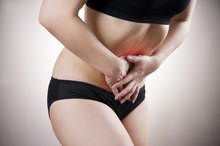What does fact checked mean?
At Healthfully, we strive to deliver objective content that is accurate and up-to-date. Our team periodically reviews articles in order to ensure content quality. The sources cited below consist of evidence from peer-reviewed journals, prominent medical organizations, academic associations, and government data.
The information contained on this site is for informational purposes only, and should not be used as a substitute for the advice of a professional health care provider. Please check with the appropriate physician regarding health questions and concerns. Although we strive to deliver accurate and up-to-date information, no guarantee to that effect is made.
Ripping Abdominal Pain
Abdominal pain or discomfort is one of the most common complaints seen in primary care practices in the United States, ranking #8 in the Centers for Disease Control's list of the top 20 reasons for patient visits to their general practitioner in 2006. Descriptions of pain such as intensity, severity and quality are very personal and subjective, so one person with "ripping" abdominal pain may not feel the same or have the same diagnosis as another person who also describes her pain as "ripping."
If you are experiencing serious medical symptoms, seek emergency treatment immediately.
Aortic Dissection
A dissecting aortic aneurysm is the most common diagnosis related to "ripping" abdominal pain that starts suddenly, and it is a very serious problem. The aorta is the largest artery in the body and supplies oxygenated blood to the rest of the body.
With this disorder, there is a tear on the inner of the aorta's two walls, which allows blood to flow out of the aorta but not all the way out, so it becomes trapped like a blister (an aneurysm). The dissection part occurs when the blood forces its way further along between those two layers, which causes the sensation of ripping or tearing.
Where the aneurysm started impacts how serious the dissection is, and generally the closer to the heart the worse. Since the aorta starts at the heart and travels down towards the belly, ripping pain can occur anywhere along its course. Pain in the front of the chest is usually associated with a dissection in the part of the aorta right by the heart (an "ascending" dissection), and pain in the back or abdomen is usually associated with the part of the aorta farther away (a "descending" dissection.) Ascending dissections are very emergent and so sudden ripping pain in the chest should result in an ER visit.
- A dissecting aortic aneurysm is the most common diagnosis related to "ripping" abdominal pain that starts suddenly, and it is a very serious problem.
- The dissection part occurs when the blood forces its way further along between those two layers, which causes the sensation of ripping or tearing.
Ruptures
What Are the Signs and Symptoms of a Stomach Aneurysm?
Learn More
"Ripping" abdominal pain is not directly associated with any other condition as clearly as with an aortic dissection, but can be seen in cases where some internal organ or structure breaks or ruptures 1. The easiest way to decide if you have a rupture is to lie on your back and have a friend press down gently onto your belly where the pain is located. If the pain becomes worse when they take their hands away (called "rebound tenderness"), then a rupture may be more likely and you should see your doctor quickly.
Structures that can rupture change depending on where in the body the pain is worst.
In the middle abdomen/stomach region, there may be a peptic ulcer in the stomach that has perforated (acid creating a hole all the way through the wall), pancreatitis that bleeds (hemorrhagic), or cholecystitis (inflamed gall bladder) that burst. All of these would have had some preexisting symptoms before their rupture, however, and should not be considered for sudden-onset or new abdominal pain. Lower abdominal ruptures are typically seen in women who suffer from a ruptured ectopic pregnancy (egg implants in the fallopian tubes instead of the uterus). This is also very dangerous, so any woman who has a sudden and severe tearing sensation in the lower abdomen (and who may have become pregnant) should go to the ER.
- "Ripping" abdominal pain is not directly associated with any other condition as clearly as with an aortic dissection, but can be seen in cases where some internal organ or structure breaks or ruptures 1, then a rupture may be more likely and you should see your doctor quickly.
Other Causes
Other causes for ripping abdominal pain are more circumstantial and may have other symptoms that are more noticeable than the "ripping" pain. All of the following possibilities require medical attention.
Trauma to the abdomen can burst organs (like the spleen or liver), which can result in a tearing sensation, but the person is much more likely to complain of the trauma itself than the specific pain they feel internally.
Old surgeries can cause something called "adhesions" in the abdomen, which is where part of the internal structures heal and stick to other structures. These adhesions can sometimes tear loose, and the pain associated with that is sudden but may be more transient.
Muscles in the abdomen can occasionally tear during use, but this is usually minor (like a strain). Complete tears of the muscles in the abdomen are exceedingly rare.
Cesarean section wounds may also re-open if the birth was recent, and can cause a ripping sensation in the lower abdomen. This requires immediate attention and surgical repair.
- Other causes for ripping abdominal pain are more circumstantial and may have other symptoms that are more noticeable than the "ripping" pain.
- Cesarean section wounds may also re-open if the birth was recent, and can cause a ripping sensation in the lower abdomen.
Non-Acute Treatment Options
Appendicitis Symptoms in Women
Learn More
For ripping pain that is not associated with any severe medical condition, some therapies might help ease the pain. Antacids such as Tums can help neutralize the acids in the stomach, but are a short-term fix and may not be as beneficial if there is extensive ulceration.
Gentle stretching of the abdominal muscles can help ease a strain, as can placing cold packs on the sore area. Bags of frozen peas are popular because they conform to the contours of the abdomen as they thaw, but no cold compress should be held to the area for more than a few minutes at a time to avoid freezing the skin.
- For ripping pain that is not associated with any severe medical condition, some therapies might help ease the pain.
- Bags of frozen peas are popular because they conform to the contours of the abdomen as they thaw, but no cold compress should be held to the area for more than a few minutes at a time to avoid freezing the skin.
Warnings
Due to the large number of dangerous causes for ripping abdominal pain, it is inadvisable to wait to be treated. Ectopic pregnancy rupture and aortic dissections are fatal in a short amount of time, so getting to an emergency room quickly is very important. Other causes are less life threatening, but still warrant a healthcare provider's examination because some (like ruptured organs) can lead to sepsis, which is a dangerous blood infection that can be fatal if left untreated.
Related Articles
References
- Ferri's Clinical Advisor: Aortic Dissection
- CDC National Health Statistics Report: National Ambulatory Medical Care Survey: 2006 Summary
- "Differential Diagnosis in Primary Care"; R. Douglas Collins; 2008
- Hiratzka LF, Bakris GL, Beckman JA, et al. 2010 ACCF/AHA/AATS/ACR/ASA/SCA/SCAI/SIR/STS/SVM Guidelines For The Diagnosis And Management Of Patients With Thoracic Aortic Disease: A Report of the American College of Cardiology Foundation/American Heart Association Task Force on Practice Guidelines, American Association for Thoracic Surgery, American College of Radiology, American Stroke Association, Society of Cardiovascular Anesthesiologists, Society for Cardiovascular Angiography and Interventions, Society of Interventional Radiology, Society of Thoracic Surgeons, and Society for Vascular Medicine. Circulation 2010; 121:e266.
- LeMaire SA, Russell L. Epidemiology of Thoracic Aortic Dissection. Nat Rev Cardiol 2011; 8:103.
- Melvinsdottir IH, Lund SH, Agnarsson BA, et al. The Incidence And Mortality Of Acute Thoracic Aortic Dissection: Results From A Whole Nation Study. Eur J Cardiothorac Surg 2016; 50:1111.
Writer Bio
Sarah White began writing professionally in 2010 and was published in the American Institute for Foreign Study newsletter in 2003. She is a member of the Honor Society of Nursing and she is pursuing a Master of Science in nursing from Columbia University.








